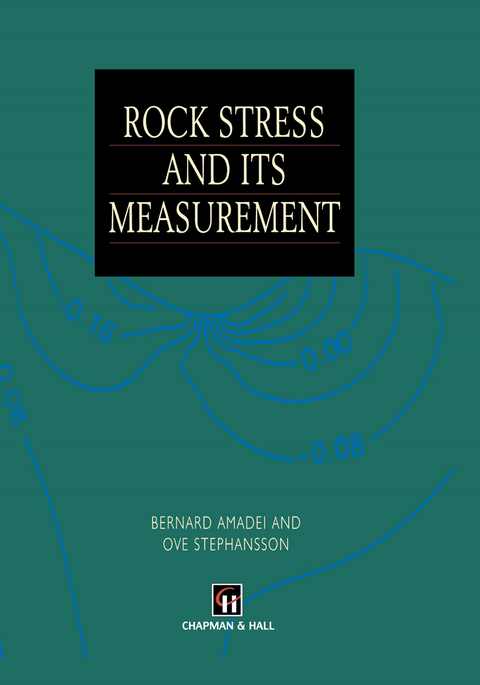
Rock Stress and Its Measurement
Chapman and Hall (Verlag)
978-0-412-44700-6 (ISBN)
Rock masses are initially stressed in their current in situ state of stress and to a lesser natural state. Whether one is interested in the extent on the monitoring of stress change. formation of geological structures (folds, faults, The subject of paleostresses is only briefly intrusions, etc. ), the stability of artificial struc discussed. tures (tunnels, caverns, mines, surface excava The last 30 years have seen a major advance our knowledge and understanding of rock tions, etc. ), or the stability of boreholes, a in the in situ or virgin stress field, stress. A large body of data is now available on knowledge of along with other rock mass properties, is the state of stress in the near surface of the needed in order to predict the response of rock Earth's crust (upper 3-4km of the crust). masses to the disturbance associated with those Various theories have been proposed regarding structures. Stress in rock is usually described the origin of in situ stresses and how gravity, within the context of continuum mechanics. It is tectonics, erosion, lateral straining, rock fabric, defined at a point and is represented by a glaciation and deglaciation, topography, curva second-order Cartesian tensor with six compo ture of the Earth and other active geological nents. Because of its definition, rock stress is an features and processes contribute to the current enigmatic and fictitious quantity creating chal in situ stress field.
1 Introduction.- 1.1 Stress at a point.- 1.2 Importance of rock stress.- 1.3 History.- 1.4 Classification of rock stresses.- 1.5 Content of the book.- 1.6 General observations.- References.- 2 Estimating in situ stresses.- 2.1 Introduction.- 2.2 Variation of in situ stresses with depth.- 2.3 Vertical and horizontal stresses as principal stresses.- 2.4 Limits of in situ stresses with depth.- 2.5 Effect of anisotropy.- 2.6 Effect of stratification.- 2.7 Effect of geological structures and heterogeneities.- 2.8 Effect of topography.- 2.9 Tectonic and residual stresses.- 2.10 Effect of erosion, overconsolidation, uplift and glaciation.- 2.11 High horizontal stresses.- 2.12 Spherical shell models of stresses in the Earth.- 2.13 Effect of boundary conditions and time on in situ stress.- 2.14 Estimating stress orientation.- 2.15 Summary.- References.- 3 Methods of in situ stress measurement.- 3.1 Introduction.- 3.2 Hydraulic methods.- 3.3 Relief methods.- 3.4 Jacking methods.- 3.5 Strain recovery methods.- 3.6 Borehole breakout method.- 3.7 Other methods.- 3.8 Rock volume in stress measurements.- 3.9 Accuracy and uncertainty in stress measurements.- References.- 4 Hydraulic methods.- 4.1 Introduction.- 4.2 Hydraulic fracturing.- 4.3 Sleeve fracturing.- 4.4 HTPF.- 4.5 Integrated stress determination method.- 4.6 Technical information.- References.- 5 Relief methods.- 5.1 Introduction.- 5.2 History.- 5.3 Techniques, equipment and procedures.- 5.4 Theory.- 5.5 Statistical analysis of overcoring measurements.- 5.6 Effect of nonlinearity on overcoring results.- 5.7 Effect of anisotropy on overcoring results.- 5.8 Technical information.- References.- 6 Jacking methods.- 6.1 Introduction.- 6.2 History.- 6.3 Techniques, equipment and procedures.- 6.4 Theory.- 6.5 Technical information.- References.- 7 Strain recovery methods.- 7.1 Introduction.- 7.2 History.- 7.3 Techniques, equipment and procedures.- 7.4 Theory.- 7.5 Data analysis and interpretation.- References.- 8 Borehole breakout method.- 8.1 Introduction.- 8.2 History.- 8.3 Techniques, equipment and procedures.- 8.4 Theory.- 8.5 Data analysis and interpretation.- References.- 9 Case studies and comparison between different methods.- 9.1 Stress measurements at the URL project.- 9.2 Comparison between different overcoring techniques.- 9.3 Comparison between hydraulic fracturing and overcoring techniques.- 9.4 Comparison between hydraulic methods.- 9.5 Comparison between hydraulic fracturing and borehole breakout methods.- References.- 10 Monitoring of stress change.- 10.1 Introduction.- 10.2 Techniques and applications.- 10.3 Technical information.- References.- 11 The state of stress in the Earth’s crust: from local measurements to the World Stress Map.- 11.1 The World Stress Map.- 11.2 Effect of scale on in situ stresses: fact or fiction?.- References.- 12 Using stresses in rock engineering, geology and geophysics.- 12.1 Introduction.- 12.2 Stresses in civil rock engineering.- 12.3 Stresses in mining engineering.- 12.4 Stresses in geology and geophysics.- References.- Appendix A Analysis of stress.- A.1 Cauchy stress principle.- A.2 State of stress at a point.- A.3 State of stress on an inclined plane.- A.4 Force and moment equilibrium.- A.5 Stress transformation law.- A.6 Normal and shear stresses on an inclined plane.- A.7 Principal stresses.- Appendix B Displacements, stresses and strains around a circular hole: anisotropic solution.- B.1 General expressions for displacement components.- B.2 Expressions for displacement components when hole axis z is perpendicular to a plane of elasticsymmetry.- B.3 Radial displacement induced by drilling a hole in an infinite anisotropic medium.- B.5 Total radial displacement around the borehole contour.- B.6 General expressions for stress components.- B.7 Stresses around a circular hole drilled in an infinite anisotropic medium under a 3D state of stress acting at infinity.- B.8 Strain components.- Author index.
| Zusatzinfo | XV, 490 p. |
|---|---|
| Verlagsort | London |
| Sprache | englisch |
| Maße | 178 x 254 mm |
| Themenwelt | Naturwissenschaften ► Geowissenschaften ► Geologie |
| Naturwissenschaften ► Geowissenschaften ► Meteorologie / Klimatologie | |
| Technik ► Bauwesen | |
| ISBN-10 | 0-412-44700-2 / 0412447002 |
| ISBN-13 | 978-0-412-44700-6 / 9780412447006 |
| Zustand | Neuware |
| Informationen gemäß Produktsicherheitsverordnung (GPSR) | |
| Haben Sie eine Frage zum Produkt? |
aus dem Bereich


